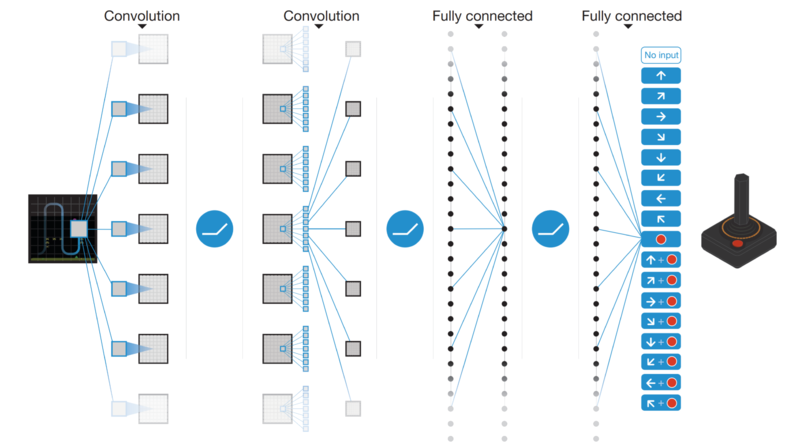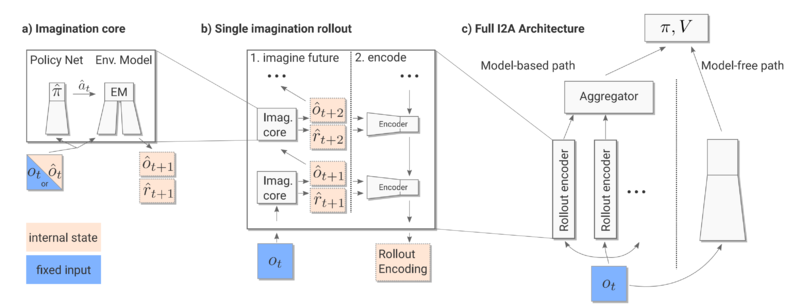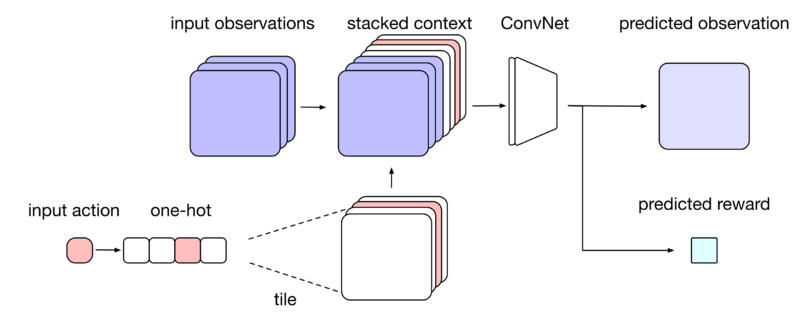Imagination-Augmented Agents for Deep Reinforcement Learning: Difference between revisions
| Line 21: | Line 21: | ||
=Approach= | =Approach= | ||
The summary of the architecture of I2A can be seen in Figure 2. | The summary of the architecture of I2A can be seen in Figure 2. | ||
[[File:i2a.png|800px|center|thumb|Figure 2: The Architecture of I2A]] | [[File:i2a.png|800px|center|thumb|Figure 2: The Architecture of I2A]] | ||
The observation $O_t$ is fed into two paths, the model-free path is just common DQN which predicts the best action given $O_t$, whereas the model-based path performs a rollout strategy and | The observation $O_t$ (Figure 2 right) is fed into two paths, the model-free path is just common DQN which predicts the best action given $O_t$, whereas the model-based path performs a rollout strategy, the aggregator combines the $n$ rollout encoded outputs($n$ equals to the number of actions in the action space), and forwards the results to next layer. Together they are used to generate a policy function $\pi$ to output an action. In each rollout operation, the imagination core is used to predict the future state and reward. | ||
===Imagination Core=== | ===Imagination Core=== | ||
The imagination core(Figure 2 left) is the key role in the model-based path. It consists of two parts: environment model and rollout policy. The former is an approximation of the environment and the latter is used to simulate imagined trajectories, which are interpreted by a neural network and provided as additional context to a policy network. | |||
====environment model==== | ====environment model==== | ||
In order to augment agents with imagination, the method relies on environment models that, given current information, can be queried to make predictions about the future. In this work, the environment model is built based on action-conditional next-step predictors, which receive input contains current observation and current action, and predict the next observation and the next reward(Figure 3). | |||
[[File:environment model.png|800px|center|thumb|Figure 3: Environment Model]] | |||
====rollout policy==== | ====rollout policy==== | ||
The rollout process is regarded as the simulated trajectories. In this work, the rollout is performed for each possible action in the environment. | |||
A rollout policy $\hat \pi$ is a function that takes current observation $O$ and outputs an action $a$ that potentially leads to maximal reward. In this architecture, the rollout policy can be a DQN network. | |||
Together as the imagination core, these two parts produces $n$ trajectories $\hat \tau_1,...,\hat \tau_n$. Each imagined trajectory $\hat \tau$ is a sequence of features $(\hat f_{t+1},...,\hat f_{t+\tau})$, where $t$ is the current time, $\tau$ the length of rollout, and $\hat f_{t+i}$ the output of the environment model(the predicted observation and reward). In order to guarantee success in imperfections, the architecture does not assume the learned model to be perfect. The output will not only depend on the predicted reward. | |||
===Model-Free Path=== | ===Model-Free Path=== | ||
Revision as of 20:33, 8 November 2017
Introduction
An interesting research area in Reinforcement Learning is developing AI for playing video games. Before Deep Learning, the AI for video games is coded based on Monte-Carlo Tree Search of pre-set rules. In recent researches, Deep Reinforcement Learning shown the success in playing video games like Atari 2600 games. To be specific, the method(Figure 1) is called Deep Q-Learning(DQN) which learns the optimal actions based on current observations(raw pixels). However, there are some complex games where DQN fails to learn: some games need to solve a sub-problem without explicit reward or contain irreversible domains, where actions can be catastrophic. A typical example of these games is Sokoban(Wikipedia). Even as humans are playing the game, planning and inference are needed. This kind of game raises challenges to RL.

In Reinforcement Learning, the algorithms can be divided into two categories: model-free algorithm and model-based algorithm. DQN, mentioned above(Figure 1), is a model-free method. It takes raw pixels as input and maps them to values or actions. As a drawback, large amounts of training data is required. In addition, the policies are not generalized to new tasks in the same environment. A model-based method is trying to build a model for the environment. By querying the model, agents can avoid irreversible, poor decisions. As an approximation of the environment, it can enable better generalization across states. However, this method only shows success in limited settings, where an exact transition model is given or in simple domains. In complex environments, model-based methods suffer from model errors from function approximation. Currently, there is no model-based method that is robust against imperfections.
In this paper, the authors introduce a novel deep reinforcement learning architecture called Imagination-Augmented Agents(I2As). Literally, this method enables agents to learn to interpret predictions from a learned environment model to construct implicit plans. It is a combination of model-free and model-based aspects. The advantage of this method is that it learns in an end-to-end way to extract information from model simulations without making any assumptions about the structure or the perfections of the environment model. As shown in the results, this method outperforms DQN in the games: Sokoban, and MniniPacman. In addition, the experiments all show that I2A is able to successfully use imperfect models.
Motivation
Although the structure of this method is complex, the motivation is intuitive: since the agent suffers from irreversible decisions, attempts in simulated stated may be helpful. To improve the expensive search space in traditional MCTS methods, adding decision from policy network can reduce search steps. In order to keep context information, rollout results are encoded by an LSTM encoder. The final output is combining the result from model-free network and model-based network.
Related Work
There are some works that try to apply deep learning to model-based reinforcement learning. The popular approach is to learn a neural network from the environment and apply the network in classical planning algorithms. These works can not handle the mismatch between the learned model and the ground truth. Liu et al.(2017) use context information from trajectories, but in terms of imitation learning.
To deal with imperfect models, Deisenroth and Rasmussen(2011) try to capture model uncertainty by applying high-computational Gaussian Process models.
Similar ideas can be found in a study by Hamrick et al.(2017): they present a neural network that queries expert models, but just focus on meta-control for continuous contextual bandit problems. Pascanu et al.(2017) extend this work by focusing on explicit planning in sequential environments.
Approach
The summary of the architecture of I2A can be seen in Figure 2.

The observation $O_t$ (Figure 2 right) is fed into two paths, the model-free path is just common DQN which predicts the best action given $O_t$, whereas the model-based path performs a rollout strategy, the aggregator combines the $n$ rollout encoded outputs($n$ equals to the number of actions in the action space), and forwards the results to next layer. Together they are used to generate a policy function $\pi$ to output an action. In each rollout operation, the imagination core is used to predict the future state and reward.
Imagination Core
The imagination core(Figure 2 left) is the key role in the model-based path. It consists of two parts: environment model and rollout policy. The former is an approximation of the environment and the latter is used to simulate imagined trajectories, which are interpreted by a neural network and provided as additional context to a policy network.
environment model
In order to augment agents with imagination, the method relies on environment models that, given current information, can be queried to make predictions about the future. In this work, the environment model is built based on action-conditional next-step predictors, which receive input contains current observation and current action, and predict the next observation and the next reward(Figure 3).

rollout policy
The rollout process is regarded as the simulated trajectories. In this work, the rollout is performed for each possible action in the environment.
A rollout policy $\hat \pi$ is a function that takes current observation $O$ and outputs an action $a$ that potentially leads to maximal reward. In this architecture, the rollout policy can be a DQN network.
Together as the imagination core, these two parts produces $n$ trajectories $\hat \tau_1,...,\hat \tau_n$. Each imagined trajectory $\hat \tau$ is a sequence of features $(\hat f_{t+1},...,\hat f_{t+\tau})$, where $t$ is the current time, $\tau$ the length of rollout, and $\hat f_{t+i}$ the output of the environment model(the predicted observation and reward). In order to guarantee success in imperfections, the architecture does not assume the learned model to be perfect. The output will not only depend on the predicted reward.